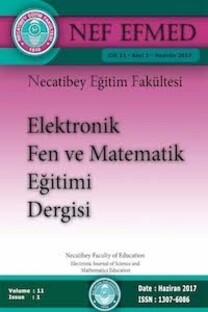Öğretmen Adaylarının Sıra Dışı Bir Tepkimenin Isısını Belirleme Konusunda Sahip Oldukları Bilimsel Muhakemelerinin İncelenmesi
Investigation of Prospective Teachers’ Scientific Reasoning for Determining the Heat of an Unusual Reaction
___
- Ary, D., Jacobs, L. C., Sorensen, C., & Razavieh, A. (2010). Introduction to research in education eight edition. Wadsworth: Cengage Learning.
- Boo, H. K. (1998). Students' understandings of chemical bonds and the energetics of chemical reactions. Journal of Research in Science Teaching, 35(5), 569-581.
- BouJaoude, S. B. (1991). A study of the nature of students' understandings about the concept of burning. Journal of Research in Science Teaching, 28(8), 689-704.
- Chinn, C. A., & Brewer, W. F. (1992a). Psychological responses to anomalous data. In Proceedings of the Fourteenth Annual Conference of the Cognitive Science Society (pp. 165-170). Hillsdale, NJ: Erlbaum
- Chinn, C. A., & Brewer, W. F. (1998). An empirical test of a taxonomy of responses to anomalous data in science. Journal of Research in Science Teaching, 35(6), 623-654.
- Chinn, C. A., & Malhotra, B. A. (2002). Children's responses to anomalous scientific data: How is conceptual change impeded?. Journal of Educational Psychology, 94(2), 327.
- Dunbar, K. (1995). How scientists really reason: Scientific reasoning in real-world laboratories. In R. J. Sternberg & J. E. Davidson (Eds.). The nature of insight (pp. 365–395). Cambridge, MA: MIT Press.
- Dunbar, K. (2001). What scientific thinking reveals about the nature of cognition. Designing for science: Implications from everyday, classroom, and professional settings, 115-140.
- Goedhart, M. J., & Kaper, W. (2002). From chemical energetics to chemical thermodynamics. In Chemical education: Towards research-based practice (pp. 339-362). Springer, Dordrecht.
- Kadayifci, H. (2017). Barriers to students’ creative evaluation of unexpected experimental findings. Journal of Baltic Science Education, 16(3), 414-428.
- Kadayifci, H. (2018) If a reaction is spontaneous, may it be endothermic? Perceptions and creation of an acceptable mental model. 7th International Conference New Perspectives in Science Education. Florence, Italy
- Kesidou, S., & Duit, R. (1993). Students' conceptions of the second law of thermodynamics— an interpretive study. Journal of Research in Science Teaching, 30(1), 85-106.
- Kirschner, P. A., Sweller, J., & Clark, R. E. (2006). Why minimal guidance during instruction does not work: An analysis of the failure of constructivist, discovery, problem-based, experiential, and inquiry-based teaching. Educational Psychologist, 41(2), 75-86.
- Klahr, D. (2005). A framework for cognitive studies and technology. In M. Gorman, R. D. Tweney, D. C. Gooding, & A. P. Kincannon (Eds.), Scientific and technological thinking (pp. 81– 95). Mawah , NJ : Lawrence Erlbaum.
- Klahr, D., & Dunbar, K. (1988). Dual space search during scientific reasoning. Cognitive Science, 12(1), 1-48.
- Koslowski, B. (2012). Scientific reasoning: Explanation, confirmation bias, and scientific practice. Handbook of the psychology of science, 151-192.
- Kuhn, T. S. (2012). The structure of scientific revolutions: 50th Anniversary Edition. University of Chicago press.
- Johnstone, A. H., MacDonald, J. J., & Webb, G. (1977). Misconceptions in school thermodynamics. Physics Education, 12(4), 248.
- Limón, M., & Carretero, M. (1997). Conceptual change and anomalous data: A case study in the domain of natural sciences. European Journal of Psychology of Education, 12(2), 213.
- Mason, L. (2000). Role of anomalous data and epistemological beliefs in middle school students’ theory change about two controversial topics. European Journal of Psychology of Education, 15(3), 329-346.
- National Research Council (NRC). (1996). National science education standards. Washington, DC: National Academy Press
- Nickerson, R. S. (1998). Confirmation bias: A ubiquitous phenomenon in many guises. Review of General Psychology, 2(2), 175-220.
- Nilsson, T., & Niedderer, H. (2014). Undergraduate students' conceptions of enthalpy, enthalpy change and related concepts. Chemistry Education Research and Practice, 15(3), 336-353.
- Park, J. (2001). Analysis of students' processes of confirmation and falsification of their prior ideas about electrostatics. International Journal of Science Education, 23(12), 1219-1236.
- Sozbilir, M., & Bennett, J. M. (2006). Turkish prospective chemistry teachers’ misunderstandings of enthalpy and spontaneity. Chemical Educator, 11(5), 355-363.
- Thomas, P. L., & Schwenz, R. W. (1998). College physical chemistry students' conceptions of equilibrium and fundamental thermodynamics. Journal of Research in Science Teaching, 35(10), 1151-1160.
- Treagust, D. F., Chittleborough, G., & Mamiala, T. L. (2002). Students' understanding of the role of scientific models in learning science. International Journal of Science Education, 24(4), 357-368.
- VandenBos, G. R. (2015). APA dictionary of psychology (2nd ed.). American Psychological Association. Washington, DC: APA.
- Windschitl, M., Thompson, J., & Braaten, M. (2008). Beyond the scientific method: Model‐ based inquiry as a new paradigm of preference for school science investigations. Science Education, 92(5), 941-967.
- ISSN: 1307-6086
- Yayın Aralığı: Yılda 2 Sayı
- Başlangıç: 2007
- Yayıncı: Balıkesir Üniv. Necatibey Eğitim Fak.
Matematik Derslerinde Öğrenci Performansını Artırmaya Yönelik Bir Ters Yüz Öğrenme Modeli
Exploring, Conjecturing and Proving with Dynamic Geometry Software: a case study
Emel ÖZDEMİR ERDOĞAN, ABDULKADİR ERDOĞAN, Zeliha DUR, Zeynep AKKURT DENİZLİ
Dinamik Geometri ile Keşif, Varsayım ve İspat Sürecinde Öğretmenin Rolü
Emel ÖZDEMİR ERDOĞAN, Abdulkadir ERDOĞAN, Zeliha DUR, Zeynep AKKURT DENİZLİ
COVID-19 Pandemi Döneminde Türkiye’deki Üniversitelerin Uzaktan Eğitim Sistemlerinin İncelenmesi
Gürhan DURAK, Serkan ÇANKAYA, SERKAN İZMİRLİ
Lise Öğrencilerinin Onuncu Sınıf Fizik Dersi Elektrik Konusundaki Ön Bilgilerinin Tespit Edilmesi
Dinamik Geometri Yazılımı ile Keşif, Varsayım ve İspat : Bir durum çalışması
Zeliha DUR, Emel ÖZDEMİR ERDOĞAN, Zeynep AKKURT DENİZLİ, Abdulkadir ERDOĞAN
